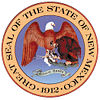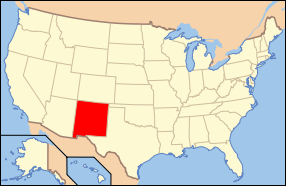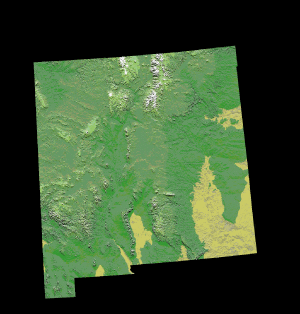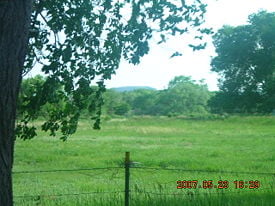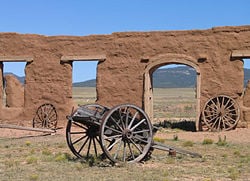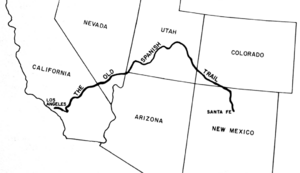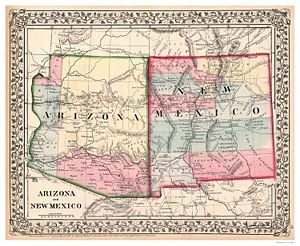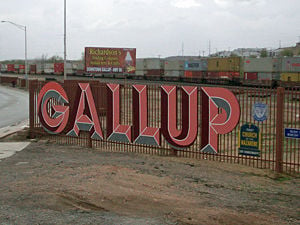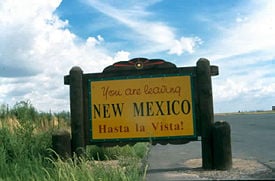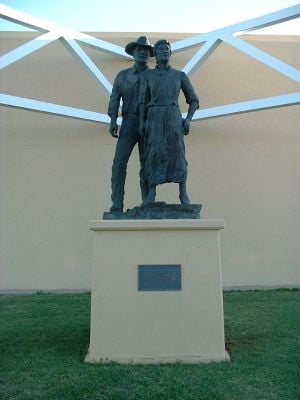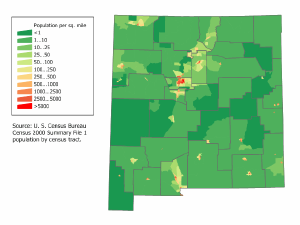New Mexico
| State of New Mexico | |||||||||||
| |||||||||||
| Official language(s) | (see text) | ||||||||||
| Spoken language(s) | English 82% Spanish 29%, Navajo 4%[1][2] | ||||||||||
| Capital | Santa Fe | ||||||||||
| Largest city | Albuquerque | ||||||||||
| Largest metro area | Albuquerque Metropolitan Area | ||||||||||
| Area | Ranked 5th | ||||||||||
| - Total | 121,589 sq mi (315,194 km²) | ||||||||||
| - Width | 342 miles (550 km) | ||||||||||
| - Length | 370 miles (595 km) | ||||||||||
| - % water | 0.2 | ||||||||||
| - Latitude | 31° 20′ N to 37° N | ||||||||||
| - Longitude | 103° W to 109° 3′ W | ||||||||||
| Population | Ranked 36th in the U.S. | ||||||||||
| - Total | 2,082,224 (2011 est)[3] | ||||||||||
| - Density | 17.2/sq mi (6.62/km2) Ranked 45th in the U.S. | ||||||||||
| Elevation | |||||||||||
| - Highest point | Wheeler Peak[4][5] 13,167 ft (4013.3 m) | ||||||||||
| - Mean | 5,700 ft (1,740 m) | ||||||||||
| - Lowest point | Red Bluff Reservoir | ||||||||||
| Admission to Union | January 6, 1912 (47th) | ||||||||||
| Governor | Susana Martinez (R) | ||||||||||
| Lieutenant Governor | John Sanchez (R) | ||||||||||
| U.S. Senators | Jeff Bingaman (D) Tom Udall (D) | ||||||||||
| Time zone | Mountain: UTC-7/-6 | ||||||||||
| Abbreviations | NM US-NM | ||||||||||
| Web site | www.newmexico.gov | ||||||||||
The State of New Mexico is in the southwestern region of the United States of America. Known as the Land of Enchantment, it became the 47th state on January 6, 1912.
Some 12,000 years ago it was occupied by Native American populations and has been part of the Spanish viceroyalty of New Spain, part of a territory of Mexico, and a U.S. territory.
Among U.S. states, New Mexico has simultaneously the highest percentage of Hispanic Americans (some recent immigrants and others descendants of Spanish colonists) and the second-highest percentage of Native Americans, after Alaska, and the fifth-highest total number of Native Americans (mostly Navajo and Pueblo peoples) after California, Oklahoma, Arizona, and Texas. As a result, the demographics and culture of the state are unique for their strong Spanish, Mexican, and U.S. Amerindian cultural influences.
New Mexico's modern history is forever linked to the world’s first atomic bomb explosion over a portion of its Jornada del Muerto desert in 1945. In those same deserts where ancient native religions worshiped, a wide variety of faiths have been establishing communities since the 1960s.
In national politics, New Mexico has given its electoral votes to all but two Presidential election winners since statehood. In these exceptions, New Mexicans supported Republican President Gerald Ford over Georgia Governor Jimmy Carter in 1976, and Democratic Vice President Al Gore over Texas Governor George W. Bush in 2000.
Etymology
New Mexico comes from the Spanish name of Nuevo Mexico; given to the region north of Mexico in the 1560s by Spanish explorers who hoped to find gold and wealth equal to Mexico's Aztec treasures. The current name is an anglicized version for this upper Rio Grande area. Mexico, an Aztec spelling, means "place of Mexitli" one of the Aztec gods.[6]
Geography
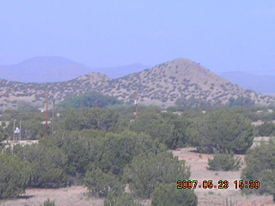
The eastern border of New Mexico lies along 103° W longitude with the state of Oklahoma, and three miles (5 km) west of 103° W longitude with Texas. On the southern border, Texas makes up the eastern two-thirds, while the Mexican states of Chihuahua and Sonora make up the western third, with Chihuahua making up about 90 percent of that. The western border with Arizona runs along the 109° 03' W longitude. The 37° N latitude parallel forms the northern boundary with Colorado. The states New Mexico, Colorado, Arizona, and Utah come together at the Four Corners in the northwestern corner of New Mexico. New Mexico covers 121,598 square miles, making it the fifth largest of the 50 states.
The eastern third of New Mexico is covered by the Great Plains. The Great Plains run from a high plateau in the north south to the Pecos River. Rivers in the high plateau have cut deep canyons into the landscape. South of the Canadian River, along the eastern edge of New Mexico, the land is referred to as the High Plains or Staked Plains (Llano Estacado). These High Plains run along the Texas border in New Mexico.
In the central part of New Mexico, the Rocky Mountains extend into New Mexico from Colorado to the north. The Rio Grande River cuts through the Rocky Mountains from north to south. East of the Rio Grande, is the Sangre de Cristo (Blood of Christ) Mountain range. Wheeler Peak, the highest point in New Mexico is found in this range. To the west of the Rio Grande are the Nacimiento and Jemez Mountain ranges. The fertile Rio Grande Valley provides suitable farm land using modern irrigation techniques.
The Basin and Range Region covers about one third of the state and lies to the south of the Rocky Mountain Region. This region extends south from around Santa Fe to Mexico and west to Arizona. This area is marked by rugged mountain ranges, including the Guadalupe, Mogollon, Organ, Sacramento, and San Andres mountain ranges, separated by desert basins. The Rio Grande River flows north to south through the Basin and Range Region and exits New Mexico in the south to form the border between Texas and Mexico, where it is known as Rio Bravo.[7]
Lakes and Rivers make up only .002 percent of the state's total surface area. The lowest water-to-land ratio of all 50 states. Most of New Mexico's lakes are man-made reservoirs. A dam constructed on the Rio Grande in 1916 formed the Elephant Butte Reservoir, the state's largest lake.[8]
The Federal government protects millions of acres of New Mexico as national forests including:
- Carson National Forest
- Cibola National Forest (headquartered in Albuquerque)
- Lincoln National Forest
- Santa Fe National Forest (headquartered in Santa Fe)
- Apache-Sitgreaves
- Gila (the sixth largest National Forest in the continental United States); Within the 3.3 million acre Gila Forest is the largest wilderness in the southwest, the Gila Wilderness. With its pristine mountains, forests, range land and protected desert it was designated in 1924 as the first wilderness area in the world.[9]
Plants
Cacti, yuccas, creosote bush, sagebrush, and desert grasses cover the broad, semiarid plains that cover the southern portion of the state.
Animals
New Mexico is home to deer, antelope, coyotes, prairie dogs, mountain lions, black bears, elk, bighorn sheep, mink, muskrats and bobcats, 300 types of birds (including the Roadrunner) and many species of insects and reptiles.
History
The first known inhabitants of New Mexico were members of the Clovis culture of Paleo-Indians(10,000 to 9,000 B.C.E.). The culture is named for the New Mexico city where the first artifacts of this culture were excavated in the early 1930s.[10] Later inhabitants include Native Americans of the Anasazi and the Mogollon cultures. By the time of European contact in the 1500s, the region was already settled by the villages of the Pueblo peoples and groups of Navajo, Apache and Ute.
Francisco Vásquez de Coronado assembled an expedition at Compostela in 1540–1542 to explore and find the mystical Seven Golden Cities of Cibola as described by Cabeza de Vaca who had just completed his eight-year expedition from Florida to Mexico. Coronado's men found several mud-baked pueblos in 1541, but found no rich cities of gold. Further widespread expeditions found no fabulous cities anywhere in the Southwest or Great Plains. A dispirited and poor Coronado and his men began their journey back to Mexico leaving New Mexico behind.
Over 50 years after Coronado, Juan de Oñate founded the San Juan colony on the Rio Grande in 1598, the first permanent European settlement in the future state of New Mexico. Oñate pioneered the El Camino Real, "The Royal Road," as a 700 mile (1,100 km) trail from New Spain to his remote colony. Oñate was made the first governor of the new Province of New Mexico and the colony, renamed San Gabriel, became the first capital of the region. The Native Americans at Acoma revolted against this Spanish encroachment but faced severe suppression.
In 1609, Pedro de Peralta, a later governor of the Province of New Mexico, established the settlement of Santa Fe at the foot of the Sangre de Cristo Mountains. The city, along with most of the settled areas of the state, was abandoned by the Spanish for 12 years (1680-1692) as a result of the successful Pueblo Revolt.
Catholic missionaries zealously converted as many Indian people as possible on the expeditions they accompanied north from Mexico. But many Pueblo people deeply resented being forced to relinquish their beliefs. The various Pueblo villages, usually in rivalry with each other, united under Pope (pronounced poh-PAY) (c. 1630 – c. 1690) a Tewa medicine man who helped organize other Pueblo leaders to orchestrate a surprise revolt against the Spanish in 1680. Many Spanish settlers were killed and the survivors fled south to what is now El Paso, Texas, along with many Christianized Indians and mestizos (persons of both Spanish and Indian blood).[11]
After the death of Pope, Diego de Vargas restored the area to Spanish rule. While developing Santa Fe as a trade center, the returning settlers founded the old town of Albuquerque in 1706, naming it for the viceroy of New Spain, the Duke of Albuquerque.
The Palace of the Governors in Santa Fe is the oldest government building in the nation. The Spanish built it as part of a fortress during the winter of 1609-1610. In 1909, it was converted to the Palace of the Governors History Museum which houses exhibits on Spanish, Mexican, and American colonization dating back to the late 1500s.
Mexican province
As a part of New Spain, the claims for the province of New Mexico passed to independent Mexico following the 1810-1821 Mexican War of Independence. During the brief 26 year period of nominal Mexican control, Mexican authority and investment in New Mexico were weak, as their often conflicted government had little time or interest in a New Mexico that had been poor since the Spanish settlements started. Some Mexican officials, saying they were wary of encroachments by the growing United States, and wanting to reward themselves and their friends, began issuing enormous land grants (usually free) to groups of Mexican families as an incentive to populate the province.
Small trapping parties from the United States had previously reached and stayed in Santa Fe, but the Spanish authorities officially forbade them to trade. Trader William Becknell returned to the United States in November 1821 with news that independent Mexico now welcomed trade through Santa Fe.
William Becknell left Independence, Missouri, for Santa Fe early in 1822 with the first party of traders. The Santa Fe Trail trading company, headed by the brothers Charles Bent and William Bent and Ceran St. Vrain, was one of the most successful in the West. They had their first trading post in the area in 1826, and, by 1833, they had built their adobe fort and trading post called Bent's Fort on the Arkansas River. This fort and trading post, located about 200 miles (322 km) east of Taos, New Mexico, was the only place settled by whites along the Santa Fe trail before it reached Taos. The Santa Fe National Historic Trail follows the route of the old trail, with many sites marked or restored.
The Spanish Trail from Los Angeles, California to Santa Fe, New Mexico was primarily used by Hispanics, white traders and ex-trappers living part of the year in or near Santa Fe. Started in about 1829, the trail was an arduous 2,400 (3,862 km) mile round trip pack-train sojourn that extended into Colorado, Utah, Nevada and California and back, allowing only one difficult round trip per year. The trade consisted primarily of blankets and some trade goods from Santa Fe being traded for horses in California.
The Republic of Texas claimed the mostly vacant territory north and east of the Rio Grande river when it successfully seceded from Mexico in 1836. New Mexico authorities captured a group of Texans who embarked on an expedition to assert their claim to the province in 1841.
American territory
Following the Mexican-American War, from 1846-1848 and the Treaty of Guadalupe Hidalgo in 1848, Mexico forcibly ceded its mostly unsettled northern holdings, today known as the American Southwest and California to the United States of America in exchange for an end to hostilities, and the evacuation of Mexico City and many other areas under American control. Mexico also received $15 million cash, plus the assumption of slightly more than $3 million in outstanding Mexican debts.
The Congressional Compromise of 1850 halted a bid for statehood under a proposed antislavery constitution. Texas transferred eastern New Mexico to the federal government, settling a lengthy boundary dispute. Under the compromise, the American government established the Territory of New Mexico on September 9, 1850. The territory, which included most of the future states of Arizona, New Mexico, and parts of Colorado, officially established its capital at Santa Fe in 1851.
The United States acquired the southwestern boot heel of the state and southern Arizona below the Gila river in the mostly desert area with the Gadsden Purchase of 1853. This purchase was desired when it was discovered that a much easier route for a proposed transcontinental railroad was located slightly south of the Gila river. The Southern Pacific built the second transcontinental railroad though this purchased land in 1881.
During the American Civil War, Confederate troops from Texas briefly occupied the Rio Grande valley as far north as Santa Fe. Union troops from the Territory of Colorado re-captured the territory in March 1862 at the Battle of Glorieta Pass. The Territory of Arizona was split off as a separate territory on February 24, 1863.
There were centuries of conflict between the Apache, the Navajo and Spanish-Mexican settlements in the territory. It took the federal government another 25 years after the Civil War to exert control over both the civilian and Native American populations of the territory. This started in 1864 when the Navajo were sent on The Long Walk to the Bosque Redondo Reservation and then returned to most of their lands in 1868. The Apache were moved to various reservations and the Apache wars continued until Geronimo finally surrendered in 1886.
In 1878 the Atchison, Topeka, and Santa Fe Railroad was completed. In 1881 the Southern Pacific Railroad was completed. The railway encouraged the great cattle boom of the 1880s and the development of accompanying cow towns. The cattle barons could not keep out sheepherders, and eventually homesteaders and squatters overwhelmed the cattlemen by fencing in and plowing under the "sea of grass" on which the cattle fed. Conflicting land claims led to bitter quarrels among the original Spanish inhabitants, cattle ranchers, and the newer homesteaders. Despite destructive overgrazing, ranching survived and remains a mainstay of the New Mexican economy.
In the 1890s and early 1900s tuberculosis(TB) became a widespread problem and the dry desert air of New Mexico became a home to many hospitals devoted entirely to its cure. At one time there were 17 sanatoriums in Albuquerque alone.[12]
Statehood
| State symbols |
(*)The official state question refers to a question commonly heard at restaurants, where waiters will ask customers "red or green?" in reference to which kind of chili pepper or "chile sauce" the customers wants served with their meal. This type of "chile" is usually distinct from salsa. |
Congress admitted New Mexico as the 47th state in the Union on January 6, 1912. The admission of the neighboring State of Arizona on February 14, 1912 completed the contiguous 48 states.
Soon afterwards political squabbling in Mexico led to the rise of revolutionary leader Pancho Villa, who felt betrayed in his bid for power by the United States. The circumstances led Villa and his band of revolutionaries to raid Columbus, N.M., on March 16, 1916. After the armed conflict, which resulted in many deaths on both sides, Villa fled south into Mexico and eluded the pursuing United States Army, marking the last time the continental United States was invaded by a foreign power.
After statehood artists, oil and nuclear power would come to play a significant role its future.
In 1917 a local patron of the arts,, writer and and socialite, Mabel Dodge Luhan would begin inviting artists like Ansel Adams, Georgia O'Keeffe, D. H. Lawrence, and Martha Graham to her residence in Taos. As a result Taos became an artist colony that still maintains its attraction to this day.
In the 1920s oil and natural gas were discovered on the Navajo reservation in New Mexico. The state has now produced 5.2 billion barrels of crude oil and 56 trillion cubic feet of natural gas since production of these resources began.[13]
Another discovery involved the United States government when it built the Los Alamos Research Center in 1943 amid the Second World War. The top-secret Manhattan Project was taking place at Los Alamos under the direction of J. Robert Oppenheimer. It was here that the atomic bomb was developed and first detonated at Trinity site in the desert on the White Sands Proving Grounds between Socorro and Alamogordo on July 16, 1945.
Also during the war the U.S. military employed many of New Mexico's Navajos to use their native language over the air waves as a top-secret wartime code that the Japanese could never break. These Navajo Code Talkers have only recently been recognized for their heroic contribution to the war.
There were also several internment camps in New Mexico during World War II, the ones at Santa Fe and Lordsburg held U.S. residents of Japanese descent. The camp at Lordsburg also held captured German and Italian soldiers. Another camp at Roswell held almost exclusively German prisoners, most of them from Gen. Erwin Rommel's elite Afrika Korps, until late in the war.[14]
After the war the state quickly emerged as a leader in nuclear, solar, and geothermal energy research and development. The Sandia National Laboratories, founded in 1949, carried out nuclear research and special weapons development at Kirtland Air Force Base south of Albuquerque and at Livermore, California. Hundreds of highly educated Scientists and Engineers moved to the state. By the 1960s New Mexico had a higher percentage of people with Ph.D.s than any other state.
The DAV Vietnam Memorial in Angel Fire was the nation's first memorial to soldiers who served in Vietnam. The official dedication took place on May 26, 1986. The following year, on November 13, 1987 the United States Congress recognized the Memorial as being of national significance and President Ronald Reagan signed a proclamation to that effect.[15]
Also the University of New Mexico's Institute of Meteoritics was officially founded in 1944 and was the first of its kind in the world.[16]
Roswell UFO Incident
In July 1947, an incident occurred in Roswell, New Mexico which has since become the subject of intense speculation, rumor, questioning and research. There are widely divergent views on what actually happened and passionate debate about what evidence can be believed. The United States military maintains that what was recovered was a top-secret research balloon that had crashed. However, many Unidentified Flying Objects (UFO) proponents believe the wreckage was of a crashed alien craft and that the military covered up the craft's recovery. The incident has turned into a widely-recognized and referenced pop culture phenomenon, and for some, Roswell is synonymous with UFOs. It likely ranks as the most famous alleged UFO incident.
Modern culture
With a Native American population of 207,400 in 2005, New Mexico still ranks as an important center of American Indian culture. Both the Navajo and Apache share Athabaskan origin. The Apache and some Ute live on federal reservations within the state. With 16 million acres (6,500,000 ha), mostly in neighboring Arizona, the reservation of the Navajo Nation ranks as the largest in the United States. The prehistorically agricultural Pueblo Indians live in pueblos scattered throughout the state, many older than any European settlement.
More than one-third of New Mexicans claim Hispanic origin, the vast majority of whom descend from the original Spanish colonists in the northern portion of the state. Most of the considerably fewer recent Mexican immigrants reside in the southern part of the state.
There are many New Mexicans who also speak a unique dialect of Spanish. New Mexican Spanish has vocabulary often unknown to other Spanish speakers. Because of the historical isolation of New Mexico from other speakers of the Spanish language, the local dialect preserves some late medieval Castillian vocabulary considered archaic elsewhere, adopts numerous Native American words for local features, and contains much Anglicized vocabulary for American concepts and modern inventions.
The presence of various indigenous Native American communities, the long-established Spanish and Mexican influence, and the diversity of Anglo-American settlement in the region, ranging from pioneer farmers and ranchers in the territorial period to military families in later decades, make New Mexico a particularly heterogeneous state.
The names of several cities in New Mexico have become synonymous with different aspects of American culture. Clovis was the location of the discovery of the first artifacts of the Paleo-Indian culture (dating some 10,000 to 12,000 years ago) discovered in North America. Los Almos and Alamogordo are forever linked to creation and detonation of an atomic bomb. Santa Fe, the state's capital, has museums, galleries, an International Folk Art Market and an Opera House that make it a cultural center that is known worldwide. Truth or Consequences is the only town in America that changed its name to attract the publicity of a national radio game show and Albuquerque is host to the famed Albuquerque International Balloon Fiesta.
Law and government
New Mexico is governed under the constitution of 1912. The legislature has a senate of 42 members and a house of representatives with 70 members. The governor is elected for four years and may be reelected. The state elects two U.S. Senators and three Representatives and has five electoral votes. The people of New Mexico have generally aligned with the Democratic party in politics, although the state joined the national trend toward conservatism in the 1980s.
Politics
In national politics, New Mexico has given its electoral votes to all but two Presidential election winners since statehood. In these exceptions, New Mexicans supported Republican President Gerald Ford over Georgia Governor Jimmy Carter in 1976, and Democratic Vice President Al Gore over Texas Governor George W. Bush in 2000. No presidential candidate has won an absolute majority in New Mexico since George H. W. Bush in 1988, and no Democrat has done so since Lyndon B. Johnson in 1964. New Mexico supported Democrats in 1992, 1996, and 2000. New Mexico was one of only two states to support Al Gore in 2000 and George Bush in 2004 (the other state was Iowa). In 2004, George W. Bush narrowly won the state's electoral votes by a margin of 0.8 percentage points with 49.8 percent of the vote. Democrat John Kerry won in Albuquerque, Las Cruces, two northwestern counties, and by large margins in six counties of Northern New Mexico (Santa Fe, Rio Arriba, Taos, Mora, San Miguel, and Guadalupe).
Major political parties in New Mexico include the Democratic [17]and Republican [18] Parties; minor qualified parties include the Green Party of New Mexico,[19] the Constitution Party[20] and Libertarian Party[21]
National issues
New Mexico is one of four U.S. states that share a border with Mexico and is therefore involved in the national issue of illegal immigration and drug smuggling. Its international border (approximately 180 miles) is open desert and is generally uninhabited with numerous roads, trails, footpaths, and ranches allowing smugglers easy entry into the U.S.
According to the Federation for American Immigration Reform (FAIR) the illegal alien population in New Mexico in 2005 was 73,000. This number is 87.1 percent above the U.S. government estimate of 39,000 in 2000, and 265 percent above the 1990 estimate of 20,000.[22]
A factor significantly impacting New Mexico is the strain drug trafficking and immigration cases puts on the federal judicial and corrections system. The U.S. District Court in New Mexico has the highest case load per judgeship in the nation and has the fourth busiest court overall in the United States. In addition to an overloaded court system, the state of New Mexico is critically short on jail space.[23]
Economy
| New Mexico Industries by 2004 Taxable Gross Receipts (000s) | |
|---|---|
| Retail Trade | 12,287,061 |
| Construction | 5,039,555 |
| Other Services (excluding Public Administration) | 4,939,187 |
| Professional, Scientific and Technology Services | 3,708,527 |
| Accommodation and Food Services | 2,438,460 |
| Wholesale Trade | 2,146,066 |
| Health Care and Social Assistance | 1,897,471 |
| Utilities | 1,654,483 |
| Mining and Oil and Gas Extraction | 1,238,211 |
| Manufacturing | 926,372 |
| Information and Cultural Industries | 849,902 |
| Unclassified Establishments | 725,405 |
| Real Estate and Rental and Leasing | 544,739 |
| Finance and Insurance | 254,223 |
| Transportation and Warehousing | 221,457 |
| Public Administration | 159,013 |
| Educational Services | 125,649 |
| Arts, Entertainment and Recreation | 124,017 |
| Admin & Support, Waste Management & Remediation | 73,062 |
| Agriculture, Forestry, Fishing and Hunting | 71,853 |
| Management of Companies and Enterprises | 48,714 |
| Totals | 39,473,429 |
| Source: State of New Mexico Department of Labor | |
The Bureau of Economic Analysis estimates that New Mexico's total state product in 2003 was $57 billion. Per capita personal income in 2003 was $24,995, 48th in the nation.[24]
Minerals are the state's richest natural resource, and New Mexico is one of the U.S. leaders in output of uranium and potassium salts. Petroleum, natural gas, copper, gold, silver, zinc, lead, and molybdenum also contribute heavily to the state's income.
The principal manufacturing industries include food products, chemicals, transportation equipment, lumber, electrical machinery, and stone-clay-glass products. More than two-thirds of New Mexico's farm income comes from livestock products, especially sheep and cattle. Limited, scientifically controlled dryland farming prospers alongside cattle ranching. Cotton, pecans, and sorghum are the most important field crops. Corn, peanuts, beans, onions, chilies, and lettuce are also grown.
Since 1997, Native American-owned tribal casinos became legal in New Mexico and since then 13 tribes have opted to open 14 casinos. A year before, in 1996, the state of New Mexico introduced the lottery. The state's gambling operations took in about $970 million in 2004 revenue. That includes more than $700 million at the tribal casinos, $158 million at the racetrack casinos, $74 million from lotteries and $37 million from "race/sports" betting.[25]
The private service economy in urban New Mexico, especially in Albuquerque, has boomed in recent decades. Since the end of World War II, the city has gained an ever-growing number of retirees, especially among armed forces veterans and government workers. It is also increasingly gaining notice as a health conscious community, and contains many hospitals and a high per capita number of massage and alternative therapists. In contrast, many heavily Native American and Hispanic rural communities remain economically underdeveloped.
Feature films have used New Mexico as a location since Thomas Edison's The Indian School in 1898. Financial incentives[26] and construction of facilities (such as The Albuquerque Studios)[27] have created opportunities for locally based crew members with production reaching an all time high in 2007. As of the end of August 2007, 30 major projects have been filmed in the state, more than in any other calendar year in history.[28]Film and television post-production is also growing with companies such as Sony Imageworks establishing a permanent home in the state.[29]
Virgin Galactic, the first space tourism company to develop commercial flights into space, has decided to put its world headquarters and mission control in Upham (25 miles (40 km) south of Truth or Consequences); its inaugural launch of the VSS Enterprise spaceship is scheduled for 2008 and it plans to begin launching ordinary citizens in early 2009.[30][31][32]
Taxes
- Personal income tax rates for New Mexico range from 1.7 percent to 5.3 percent, within four income brackets.
- New Mexico does not have a sales tax. Instead, it has a five percent gross receipts tax. In almost every case, the business passes along the tax to the consumer, so that the gross receipts tax resembles a sales tax. The combined gross receipts tax rate varies throughout the state from 5.125 percent to 7.8125 percent. The total rate is a combination of all rates imposed by the state, counties and municipalities. Beginning Jan. 1, 2005, New Mexicans no longer pay taxes on most food purchases; however, there are exceptions to this program. Also beginning Jan. 1, 2005, the state eliminated the tax on certain medical services.
- In general, taxes are not assessed on personal property. Personal household effects, licensed vehicles, registered aircraft, certain personal property warehoused in the state and business personal property that is not depreciated for federal income tax purposes are exempt from the property tax.
- Property tax rates vary substantially and depend on the type of property and its location. The state does not assess tax on intangible personal property. There is no inheritance tax, but an inheritance may be reflected in a taxpayer's modified gross income and taxed that way.
Military
Federal government spending is a major driver of the New Mexico economy. The federal government spends $2 on New Mexico for every dollar of tax revenue collected from the state. This rate of return is higher than any other state in the Union.[33] The federal government also is a major employer in New Mexico providing more than a quarter of the state's jobs. Many of the federal jobs relate to the military (see below). In addition to the military employers, other federal agencies such as the National Park Service, the United States Forest Service, and the United States Bureau of Land Management are a big part of the state's rural employment base.
In addition to the National Guard, New Mexico has a State Defense Force.
The state also hosts three air force bases (Kirtland Air Force Base, Holloman Air Force Base, and Cannon Air Force Base); a testing range (White Sands Missile Range); an army proving ground and maneuver range (Fort Bliss Military Reservation - McGregor Range);national observatories; and the technology labs of Los Alamos National Laboratory (LANL) and Sandia National Laboratories (SNL). SNL conducts electronic and industrial research on Kirtland AFB, on the southeast side of Albuquerque. These installations also include the missile and spacecraft proving grounds at White Sands.
Transportation
The Atchison, Topeka and Santa Fe Railway often abbreviated as ATSF, or referred to as simply Santa Fe, was one of the largest railroads in the United States after it was first chartered in February 1859. Although the railway was named in part for the capital of New Mexico, its main line never reached there as the terrain made it too difficult to lay the necessary tracks (Santa Fe was ultimately served by a branch line from Lamy, New Mexico). The Atchison, Topeka and Santa Fe Railway officially ceased operations on December 31, 1996 when it merged with the Burlington Northern Railroad to form the Burlington Northern and Santa Fe Railway (BNSF).
Roadways
New Mexico has three interstate highway systems, all of which are considered major cross-country routes. These are east-west I-10, I-40, and north-south I-25, which begins at Las Cruces. The state does not have what is commonly referred to as "beltways," highways that encircle the major cities in order to avoid city traffic. However, there are Interstate Business Loops in a number of urban areas, which bypass business district traffic. [34] There is also an extensive state highway system which serves the state well.
Tourism
In 1997 tourism was the largest private-sector employer in the state, with more than 50,000 workers directly dependent on tourist dollars. In 1980, according to New Mexico Department of Tourism spokesman Mike Pitel, tourism generated yearly income of around a billion dollars. By 1989, that figure had doubled. Five years after that tourist dollars injected into the state had increased to $3 billion.[35] In 2006 the New Mexico tourism industry generated $5 billion for the state’s economy, employed 80,000 people and brought in more than $300 million in taxes.[36]
National monuments
- Aztec Ruins National Monument at Aztec
- Bandelier National Monument in Los Alamos
- Capulin Volcano National Monument near Capulin
- El Camino Real de Tierra Adentro National Historic Trail
- El Malpais National Monument in Grants
- El Morro National Monument in Ramah
- Fort Union National Monument at Watrous
- Gila Cliff Dwellings National Monument near Silver City
- Petroglyph National Monument near Albuquerque
- Salinas Pueblo Missions National Monument at Mountainair
- White Sands National Monument near Alamogordo
- Kasha-Katuwe Tent Rocks National Monument
National Parks
- Carlsbad Caverns National Park near Carlsbad
- Chaco Culture National Historical Park at Nageezi
Historic trails
- Old Spanish National Historic Trail
- Santa Fe National Historic Trail
- Catwalk National Recreation Trail
Historic Park
- Pecos National Historical Park in Pecos
National Preserve
- Valles Caldera National Preserve.
Other points of interest
- San Miguel Mission
- Cathedral Basilica of Saint Francis of Assisi
- Georgia O'Keeffe Museum
- Museum of International Folk Art
- Santa Fe Indian Market
- Taos Pueblo
- Taos art colony
- Acoma Sky Pueblo
- New Mexico Museum of Natural History and Science
- Albuquerque Biological Park
- National Atomic Museum
- Indian Pueblo Cultural Center
- Cumbres and Toltec Scenic Railroad, Chama
- Roswell UFO Landing Site
- International UFO Museum
- Spaceport America
- Billy the Kid Museum, Fort Sumner
- Historic Lincoln, Ruidoso, and Mescalero Apache Indian Reservation
- Silver City was a gold mining town in the Wild West.
Education
The Catholic Church played an important role in education in New Mexico in its early years. In 1853, a small group of Catholic Sisters opened the Academy of Our Lady of Light, a school known also as the Loretto School for Girls. This school remained in operation for more than a century, closing in 1966.
In 1859, Bishop Lamy arranged with the Christian Brothers to open a similar school for boys. El Colegio de San Miguel, as it was originally known, eventually evolved to provide post-secondary education at St. Michael’s College. Both of these early institutions continue their mandate as St. Michael’s High School and the College of Santa Fe.
The Sisters of Loretto and the Christian Brothers opened several more schools throughout the territory. These were joined by several other orders, including the Sisters of Charity, Sisters of Mercy, and Sisters of the Blessed Sacrament, and by 1900 at least 15 Catholic schools were operating throughout New Mexico.[37]
Public education was almost non-existent in New Mexico until the end of the nineteenth century. As late as 1888 there was not a single public college or high school in the entire territory. New Mexico established a system of public schools in 1891.
Secondary education
New Mexico has 1,061 schools: 856 public schools; 205 private schools, and 604 elementary schools, 166 middle schools, 180 high schools.[38]
Colleges and universities
According to "The Condition of Higher Education in New Mexico Report for 2005-2006" the State of New Mexico supports:
- Three high quality research universities, each of which has received national recognition in areas of specialization;
- Four comprehensive universities which provide the benefits of small residential colleges at relatively low tuition rates;
- Seventeen two-year colleges, ten of which operate as branch campuses of the universities and seven as independent community colleges; they are located around the state so that every New Mexican resident has geographic access to higher education; and
- Three special schools.
It also reported that enrollment at New Mexico’s public institutions of higher education was relatively flat with an overall enrollment increase of less than one percent from Fall 2004 to Fall 2005.[39]
State Universities
- University of New Mexico Established in 1889 it currently has an enrollment of a little more than 8,000 students at its Albuquerque campus.
- New Mexico State University founded in 1888 as an agricultural college and preparatory school. The statewide system with six different campuses had a total fall 2006 enrollment of 27,150.
- Eastern New Mexico University Opened in 1934 it is New Mexico's largest regional comprehensive university. It has more than 4,000 students at its main campus in Portales.
- Western New Mexico University Established in 1893 by the New Mexico Territorial Legislature as a higher learning institution for teacher training. It has almost 2,000 students at its main campus in Silver City.
- New Mexico Highlands University Established as New Mexico Normal School in 1893, the institution became New Mexico Highlands University in 1941. The majority of its approximately 3,500 students are from New Mexico and are Hispanic. Highlands’ programs focus on its multi-ethnic student body, especially the Hispanic and Native American cultures distinctive of New Mexico.
Higher education institutes
|
|
Demographics
In 2006 New Mexico was the fastest growing state in the United States, and accounted for the largest increase in population size.[40] New Mexico's estimated population of 1,928,384, is an increase of 25,378, or 1.3 percent, from the prior year and an increase of 109,338, or 6.0 percent, since the year 2000. This includes a natural increase since the last census of 74,397 people (that is 143,617 births minus 69,220 deaths) and an increase due to net migration of 37,501 people into the state. Immigration from outside the United States resulted in a net increase of 27,974 people, and migration within the country produced a net increase of 9,527 people.
New Mexico’s foreign-born population increased by 17.7 percent between 2000 and 2006. During that period New Mexico gained over 26,000 immigrants, bringing the total number of foreign-born residents in the state to over 176,000.[41]
7.2 percent of New Mexico's population was reported as under 5 years of age, 28 percent under 18, and 11.7 percent were 65 or older. Females make up approximately 50.8 percent of the population.
Ancestry groups
According to the Census Bureau, 1.5 percent of the population is Multiracial/Mixed-Race, a population larger than both the Asian and NHPI population groups. New Mexico has the highest percentage of people of Hispanic ancestry of any state, some recent immigrants and others descendants of Spanish colonists. The state also has a large Native American population, third behind Alaska and Oklahoma in percent of population. Hispanics of colonial ancestry, along with recent Mexican immigrants, are present in most of the state, especially northern, central, and northeastern New Mexico. Mexican immigrants, legal or illegal, are prominent in southern parts of the state. The northwestern corner of the state is primarily occupied by Native Americans, of which Navajos and Pueblos are the largest tribes. As a result, the demographics and culture of the state are unique for their strong American, Colonial Spanish, Mexican, and Native American cultural influences.
According to the U.S. Census, the largest ancestry groups in New Mexico are:
 Mexican (18.1 percent)
Mexican (18.1 percent) Native American (10.3 percent)
Native American (10.3 percent) German (9.8 percent)
German (9.8 percent) Hispanic (9.4 percent)
Hispanic (9.4 percent) Spanish (9.3 percent)
Spanish (9.3 percent) English (7.6 percent)
English (7.6 percent) Irish (7.3 percent).
Irish (7.3 percent).
Many are mixtures of all of these groups and others.
Languages
According the 2000 U.S. Census, 28.76 percent of the population aged 5 and over speak Spanish at home, while 4.07 percent speak Navajo[42].
New Mexico is commonly thought to have Spanish as an official language alongside English, due to the widespread usage of Spanish in the state. Although the original state constitution of 1912 provided for a temporarily bilingual government, New Mexico has no official language. Nevertheless, the state government publishes election ballots and a driver's manual in both languages, and, in 1995, New Mexico adopted a "State Bilingual Song," titled "New Mexico-Mi Lindo Nuevo México."[43]
Religion
New Mexico has the highest percentage of Roman Catholics of any Western U.S state. In 1990 New Mexico had 467,356 Catholics, which represented 30.85 percent of its population.[44] In comparison to other U.S. states, and like many other states in the region, New Mexico has a higher-than-average percentage of people who claim no religion.[45]
- Jewish - 0.6 percent
- Christian – 81 percent
- Roman Catholic – 41 percent
- Protestant – 35 percent
- Baptist – 10 percent
- Presbyterian – 4 percent
- Pentecostal – 3 percent
- Other Protestant or general Protestant – 18 percent
- LDS (Mormon) – 4 percent
- Other Christian – 1 percent
- Other Religions – 1 percent
- Non-Religious – 19 percent
By the 1990s New Mexico had evolved into a "spiritual magnet" for a wide variety of faiths. From the 1960s forward, utopians of found homes in Taos, Sikhs settled in Española, Moslems in Abiquiu, Scientologists in Trementina, Pentecostals in the Llano Estacado and elsewhere, and a variety of "New Agers" in the region of Santa Fe. New Mexico Archbishop Michael Sheehan's six 1994 public billboards in Albuquerque reflected both the hope and the reality of this unique situation. Said the archbishop: "Let us all live together as the sons and daughters of God."[46]
Notable New Mexicans
Many New Mexicans—those who were born, raised, or lived a significant period in New Mexico—have gained local, national, and international prominence. New Mexico Governor Bill Richardson is currently one of the candidates for the 2008 United States presidential election. Notable businessmen include Jeff Bezos, founder of Amazon.com, and Conrad Hilton, founder of the Hilton Hotels Corporation. New Mexicans have also studied outer space, notably NASA astronauts Sidney M. Gutierrez and Harrison Schmitt. Astronomer Clyde Tombaugh, a former New Mexico State University professor, discovered Pluto.
Several New Mexicans have served roles in popular culture, including folk singer/songwriter John Denver, artist Georgia O'Keeffe, animator William Hanna, actor Neil Patrick Harris and actress Demi Moore, Pulitzer Prize winners Bill Mauldin and Ernie Pyle, and author D. H. Lawrence. Athletes like Ross Anderson (skier) fastest skier in history for the Western Hemisphere and World Cup/Professional Speed Skier with a speed of 154.060 MPH on Alpine skis.
Notes
- ↑ Error on call to template:cite web: Parameters url and title must be specified. United States Census 2000. United States Census Bureau (February 25, 2003).
- ↑ Error on call to template:cite web: Parameters url and title must be specified. Census 2000 Brief. United States Census Bureau (October 2003).
- ↑ Error on call to template:cite web: Parameters url and title must be specified (CSV). 2011 Population Estimates. United States Census Bureau, Population Division (December 2011).
- ↑ 4.0 4.1 Elevations and Distances in the United States. United States Geological Survey (2001). Retrieved October 24, 2011.
- ↑ 5.0 5.1 Elevation adjusted to North American Vertical Datum of 1988.
- ↑ State Symbols: State's Names, 50 States Shgresources.com.
- ↑ The Geography of New Mexico Netstate.com. Retrieved October 19, 2007.
- ↑ New Mexico Facts and Trivia 50states.com. Retrieved October 10, 2007.
- ↑ Gila National Forest Desertusa.com. Retrieved October 10, 2007.
- ↑ Clovis People Crystalinks.com. Retrieved October 10, 2007.
- ↑ NMmagazine.com. New Mexico History Retrieved October 14, 2007.
- ↑ Deborah Kent. New Mexico. America the Beautiful. (New York: Children's Press/Grolier Pub., 1999. ISBN 0516206907), 46
- ↑ Ronald F. Broadhead, Remaining Oil and Natural Gas Resources of New Mexico New Mexico Bureau of Geology and Mineral Resources. Retrieved October 15, 2007.
- ↑ World War II P.O.W. Camps in New Mexico New Mexico Office of the State Historian. Retrieved October 7, 2007.
- ↑ The David Westphall Veterans Foundation Angelfirememorial.com. Retrieved October 7, 2007.
- ↑ History of the Institute of Meteoritics University of New Mexico College of Arts and Sciences.
- ↑ Democratic Party of New Mexico Retrieved October 31, 2007.
- ↑ Republican Party of New Mexico Retrieved October 31, 2007.
- ↑ Green Party of New MexicoRetrieved October 31, 2007.
- ↑ Constitution Party, Retrieved October 31, 2007.
- ↑ Libertarian Party. Retrieved October 31, 2007.
- ↑ Immigration Impact Fairus.org. Retrieved October 17, 2007.
- ↑ DEA Briefs and Background U.S. Drug Enforcement Administration. Retrieved October 14, 2007.
- ↑ U.S. Economic Accounts. U.S. Department of Commerce Bureau of Economic Analysis. Retrieved September 22, 2007.
- ↑ Paul Krza, September 16, 2005. New Mexico gaming racks up big returns New Mexico Business Weekly. Retrieved October 17, 2007.
- ↑ NMpartnership.com. March 4, 2002 Governor Signs Film Production Tax Incentives Retrieved September 22, 2007.
- ↑ Wolf Schneider, (September 18, 2007). "Facilities fuel New Mexico production boom". The Hollywood Reporter.
- ↑ New Mexico Filmography NMpartnership.com. Retrieved September 22, 2007.
- ↑ Erik Seimers, (May 27, 2007). "Special effects company to open Duke City branch". Albuquerque Tribune. Retrieved September 22, 2007.
- ↑ Virgin Galactic's Overview. Virgingalactic.com. Retrieved September 22, 2007.
- ↑ Spaceports.blogspot.com. September 28, 2006. Virgin Galactic Readies Tourist Spacecraft for 2009 Flight. Retrieved September 22, 2007.
- ↑ Scott Allen. Richard Branson - The Rebel Billionaire and the Ultimate Multipreneur. Answers.com.
- ↑ Federal Taxes Paid vs. Spending Received by State Taxfoundation.org. Retrieved October 17, 2007.
- ↑ Steve Riner, April 7, 2007. U.S. Highways in New Mexico Steve-riner.com. Retrieved October 26, 2007.
- ↑ Dennis Wall, April 1997. Despite its natural beauty, New Mexico can't sell itself - tourism New Mexico Business Journal. Retrieved October 17, 2007.
- ↑ Farmington Convention and Visitors Bureau Farmingtonnm.org. Retrieved October 17, 2007.
- ↑ Catholic Education in New Mexico Csoadmin.org. Retrieved October 15, 2007.
- ↑ Elementary Schools in New Mexico New-mexico.schooltree.org. Retrieved October 15, 2007.
- ↑ The Condition of Higher Education in New Mexico 2005-2006New Mexico Higher Education Department. Retrieved October 15, 2007.
- ↑ Immigration Impact Fairus.org. Retrieved October 17, 2007.
- ↑ Immigration Impact Fairus.org. Retrieved October 17, 2007.
- ↑ Most spoken languages in New Mexico. MLA Language Map Data Center. Retrieved September 22, 2007.
- ↑ Language Rights and New Mexico Statehood. The Excluded Student: Educational Practices Affecting Mexican Americans in the Southwest, Mexican American Education Study, Report III (Washington, D.C.: U.S. Government Printing Office, 1972), 76-82. Retrieved September 22, 2007.
- ↑ The Largest Catholic Communities Adherents.com. Retrieved October 19, 2007.
- ↑ Makeyougohmm.com. July 23, 2006. USA Today Poll Retrieved October 19, 2007.
- ↑ Ferenc Morton Szasz and Richard W. Etulain. Religion in Modern New Mexico. (Albuquerque, NM: University of New Mexico Press, 1997 ISBN 9780585277929), viii.
ReferencesISBN links support NWE through referral fees
- Bancroft, Hubert Howe. The Works of Hubert Howe Bancroft, Vol. XVII. (History of Arizona and New Mexico 1530-1888) (original 1889); reprint 1962. online edition
- Beck, Warren. Historical Atlas of New Mexico 1969.
- Chavez, Thomas E. An Illustrated History of New Mexico, University of New Mexico Press 2002. ISBN 0826330517
- Dawdon, Joseph G., III. Doniphan's Epic March; The 1st Missouri Volunteers in the Mexican War. Kansas Press [1]
- Ellis, Richard, ed. New Mexico Past and Present: A Historical Reader. 1971. primary sources
- Getz, Lynne Marie Schools of Their Own: The Education of Hispanos in New Mexico, 1850-1940 (1997)
- Gonzales-Berry, Erlinda and David R. Maciel, editors, The Contested Homeland: A Chicano History of New Mexico. University of New Mexico Press, 2000. ISBN 0826321992
- González, Nancie L. The Spanish-Americans of New Mexico: A Heritage of Pride. 1969.
- Gutiérrez, Ramón A. When Jesus Came, the Corn Mothers Went Away: Marriage, Sexuality, and Power in New Mexico, 1500-1846. 1991.
- Hain, Paul L., F. Chris Garcia, and Gilbert K. St. Clair; New Mexico Government, 3rd ed., 1994.
- Hillerman, Tony The Great Taos Bank Robbery and other Indian Country Affairs. Albuquerque, NM: University of New Mexico Press, 1973. ISBN 082630530X
- Holmes, Jack E. Politics in New Mexico. 1967.
- Horgan, Paul. Great River, The Rio Grande in North American History. Wesleyan University Press, 1991. ISBN 0585380147 (Pulitzer Prize 1955)
- Sante Fe Trail: 72 References Kansas Historical Society [2]
- Kern, Robert W. Labor in New Mexico: Strikes, Unions, and Social History, 1881-1981. University of New Mexico Press, 1983. ISBN 0826306756
- Lamar, Howard R. The Far Southwest, 1846-1912: A Territorial History. (original 1966) 2000.
- Larson, Robert W. New Mexico's Quest for Statehood, 1846-1912. 1968.
- Nieto-Phillips, John M. The Language of Blood: The Making of Spanish-American Identity in New Mexico, 1880s-1930s. University of New Mexico Press, 2004. ISBN 08236324231
- Simmons, Marc. New Mexico: An Interpretive History. University of New Mexico Press, 1988. ISBN 0826311105
- Sánchez, George I. Forgotten People: A Study of New Mexicans. (original 1940) 1996.
- Szasz, Ferenc M. and Richard W. Etulain. Religion in Modern New Mexico. 1997. ISBN 0585277923
- Weber David J. (ed.) Foreigners in Their Native Land: Historical Roots of the Mexican Americans, revised ed. (original 1973). University of New Mexico Press, 2004. primary sources to 1912
- __________, et al. The Mexican Frontier, 1821-1846: The American Southwest under Mexico. (Histories of the American Frontier) University of New Mexico Press, 1982. ISBN 9780826306036
External links
All links retrieved November 11, 2022.
- State of New Mexico
- New Mexico Department of Cultural Affairs
- New Mexico Magazine
- "Indigenous Peoples of New Mexico" Cybergata.com.
| State of New Mexico Santa Fe (capital) | |
| Topics | Culture |
Economy | Education | Geography | Government | History | Landmarks | Military | Natural history | Politics | Transportation | Tribes | New Mexicans | Settlements |
| Regions | Central New Mexico |
Colorado Plateau | Eastern New Mexico | Llano Estacado | Northern New Mexico | Permian Basin | Sangre de Cristo Mountains | San Luis Valley | Southwestern New Mexico |
|
Cities |
Alamogordo |
Albuquerque | Angel Fire | Artesia | Carlsbad | Clovis | Corrales | Deming | Española | Farmington | Gallup | Grants | Hobbs | Las Cruces | Las Vegas | Los Alamos | Los Lunas | Lovington | Portales | Rio Rancho | Roswell | Ruidoso | Santa Fe | Silver City | Socorro | Sunland Park |
| Counties | Bernalillo |
Catron | Chaves | Cibola | Colfax | Curry | De Baca | Doña Ana | Eddy | Grant | Guadalupe | Harding | Hidalgo | Lea | Lincoln | Los Alamos | Luna | McKinley | Mora | Otero | Quay | Rio Arriba | Roosevelt | Sandoval | San Juan | San Miguel | Santa Fe | Sierra | Socorro | Taos | Torrance | Union | Valencia |
| Political divisions of the United States | |||||||
|---|---|---|---|---|---|---|---|
| |||||||
| Preceded by: Oklahoma |
List of U.S. states by date of statehood Admitted on January 6, 1912 (47th) |
Succeeded by: Arizona |
Credits
New World Encyclopedia writers and editors rewrote and completed the Wikipedia article in accordance with New World Encyclopedia standards. This article abides by terms of the Creative Commons CC-by-sa 3.0 License (CC-by-sa), which may be used and disseminated with proper attribution. Credit is due under the terms of this license that can reference both the New World Encyclopedia contributors and the selfless volunteer contributors of the Wikimedia Foundation. To cite this article click here for a list of acceptable citing formats.The history of earlier contributions by wikipedians is accessible to researchers here:
The history of this article since it was imported to New World Encyclopedia:
Note: Some restrictions may apply to use of individual images which are separately licensed.

